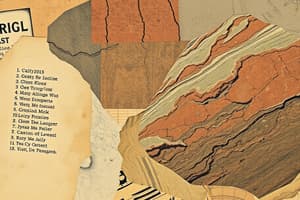Podcast
Questions and Answers
What are igneous rocks?
What are igneous rocks?
- Rocks that form from melted rock (correct)
- Rocks formed from the remains of living organisms
- Rocks that have changed due to heat and pressure
- Rocks that form in layers
What is a metamorphic rock?
What is a metamorphic rock?
Rocks that have changed as a result of heat and pressure
What are sedimentary rocks?
What are sedimentary rocks?
Rocks that form when layers of sediment settle on top of one another and harden.
Earth's crust is made of ________ example of ________ and ________
Earth's crust is made of ________ example of ________ and ________
Rocks can be classified by how they are ________
Rocks can be classified by how they are ________
List the three main types of rocks.
List the three main types of rocks.
What is magma?
What is magma?
Rocks formed from molten rock are called _____ rocks.
Rocks formed from molten rock are called _____ rocks.
The term 'igneous' comes from the Latin word meaning _____.
The term 'igneous' comes from the Latin word meaning _____.
When magma reaches Earth's surface as _____, it cools quickly and hardens into solid igneous rock in just a few _____ to _____.
When magma reaches Earth's surface as _____, it cools quickly and hardens into solid igneous rock in just a few _____ to _____.
Pumice is formed by air quickly cooling lava, which traps gas bubbles in this type of rock.
Pumice is formed by air quickly cooling lava, which traps gas bubbles in this type of rock.
What happens when magma cools slowly?
What happens when magma cools slowly?
Why would you need a microscope to see an igneous rock's crystals?
Why would you need a microscope to see an igneous rock's crystals?
_____ rock forms when layers of sediment settle on top of one another and harden.
_____ rock forms when layers of sediment settle on top of one another and harden.
What makes up sediment?
What makes up sediment?
How are sedimentary rocks classified?
How are sedimentary rocks classified?
Examples of sedimentary rocks include:
Examples of sedimentary rocks include:
Metamorphic rocks can change form completely due to ____ and ____.
Metamorphic rocks can change form completely due to ____ and ____.
What may heat and pressure cause to change?
What may heat and pressure cause to change?
Chemical changes in the rock may form ________ types of minerals.
Chemical changes in the rock may form ________ types of minerals.
Graphite is made entirely of _____.
Graphite is made entirely of _____.
What can graphite be turned into?
What can graphite be turned into?
What is a much harder mineral on the Mohs scale?
What is a much harder mineral on the Mohs scale?
Some minerals have ________, meaning they may break along a smooth flat surface.
Some minerals have ________, meaning they may break along a smooth flat surface.
Hardness is how easily a mineral can be _____.
Hardness is how easily a mineral can be _____.
Each mineral has crystals that are a particular shape called _____.
Each mineral has crystals that are a particular shape called _____.
What is the term for the color left by a mineral scratched on a special plate?
What is the term for the color left by a mineral scratched on a special plate?
What is luster in terms of minerals?
What is luster in terms of minerals?
The same mineral can be different in terms of _____?
The same mineral can be different in terms of _____?
What are minerals?
What are minerals?
Flashcards are hidden until you start studying
Study Notes
Classification of Rocks
- Igneous Rocks: Formed from melted rock; can be classified as either intrusive or extrusive based on cooling location and speed.
- Metamorphic Rocks: Created under heat and pressure, resulting in physical and chemical changes in existing rocks.
- Sedimentary Rocks: Developed through layers of sediment compacting and cementing over time.
Types of Rocks
- Three Main Kinds: Igneous, sedimentary, and metamorphic represent the primary classifications of rocks.
- Examples of Igneous Rocks: Include granite, obsidian, gabbro, and pegmatite, with characteristic properties based on cooling processes.
- Examples of Sedimentary Rocks: Comprise limestone, sandstone, shale, and mudstone.
Formation Processes
- Magma: Refers to molten rock found beneath the Earth's surface; when it surfaces as lava, it cools quickly.
- Cooling of Lava: Rapid cooling leads to smaller crystals; slower cooling allows larger crystals to form.
- Sediment Composition: Includes rocks, soil, shells, and organic matter, which accumulate and result in sediment formation.
Metamorphism
- Metamorphic Processes: Involves the transformation of existing rocks due to heat, pressure, and chemical changes.
- Crystal Changes: Heat and pressure can alter mineral crystals, forming new mineral types.
Mineral Characteristics
- Cleavage: Some minerals may split along smooth surfaces; not all possess this property.
- Hardness: Describes how easily a mineral can be scratched; measured using the Mohs scale.
- Crystal Shape: Each mineral features a unique crystal structure.
- Streak: The color left behind when a mineral is scratched on a plate.
- Luster: Refers to the way a mineral's surface reflects light, affecting its appearance.
Unique Properties
- Graphite: Composed entirely of carbon; subjected to heat and pressure can transform into diamond, a much harder mineral.
- Color Variability: The same mineral may appear in different colors due to impurities or other factors, affecting identification.
Summary of Rock Lifecycle
- Weathering and Erosion: Processes that move sediment locations, with deposition occurring layer by layer over time, held together by weight and chemical processes.
Studying That Suits You
Use AI to generate personalized quizzes and flashcards to suit your learning preferences.




